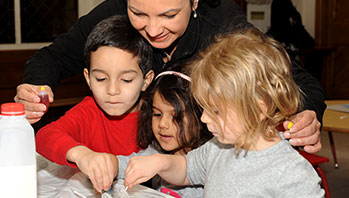- containers with lids (plastic)
- recording device (optional)
- small objects (for example, dried beans, beads, paper clips, cotton balls, packing peanuts)
- tubes and hoses (cardboard and plastic)
- predict
- sound
MA Standards:
Speaking and Listening/SL.PK.MA.1: Participate in collaborative conversations with diverse partners during daily routines and play.
MA Draft Standards:
Physical Sciences/Energy PS4.A: Investigate different sounds made by different objects and different materials and reason about what is making the sounds. [Cause and Effect]
Head Start Outcomes:
Logic and Reasoning/Reasoning and Problem Solving: Recognizes cause and effect relationships.
Logic and Reasoning/Reasoning and Problem Solving: Classifies, compares, and contrasts objects, events, and experiences.
Science Knowledge/Scientific Skills and Method: Uses senses and tools, including technology, to gather information, investigate materials, and observe processes and relationships.
PreK Learning Guidelines:
English Language Arts/Language 2: Participate actively in discussions, listen to the ideas of others, and ask and answer relevant questions.
Science and Technology/Living Things and Their Environment 15: Use their senses of sight, hearing, touch, smell, and taste to explore their environment using sensory vocabulary.
Small Group: Shake and Listen Some More

© Commonwealth of Massachusetts, Department of Early Education and Care (Jennifer Waddell photographer). All rights reserved.
STEM Key Concepts: Different objects make different sounds; An action has to happen to make a sound; A sound becomes louder when the force of the action that is creating the sound is increased; A sound becomes softer, or quieter, when the force is decreased
ELA Focus Skills: Speaking and Listening, Vocabulary
Make the materials available at the Science and Math Center. Allow children to freely explore making sounds with the materials. Join small groups of children as they explore the materials. Notice what captures their attention and engage children in conversation about their discoveries. For example, ask,
- What are you wondering about the sound the paper clips will make?
- What do you predict will happen when you shake the cotton balls? Did that happen?
- Can you describe the sound you made with the dried beans? Encourage children to use new vocabulary and made up descriptive words (bangy, chimy) while describing sounds they make.
Take It Further: You may want to help children record a soft sound and then a loud sound from their favorite shaker. Prompt children to say their name and a brief comment about how they made the sound on the recording. Other children may enjoy listening to the tape and creating similar sounds.
